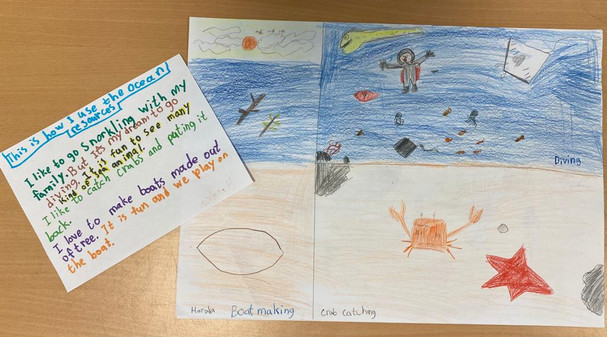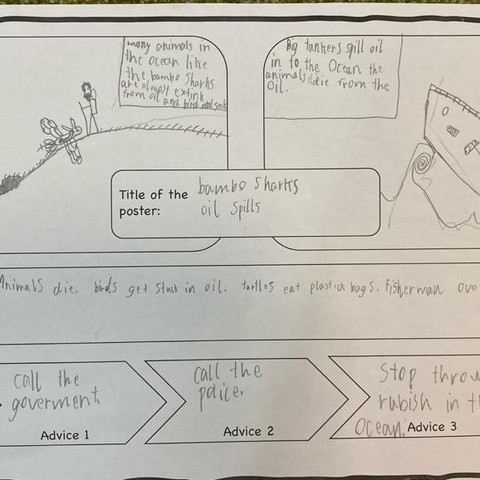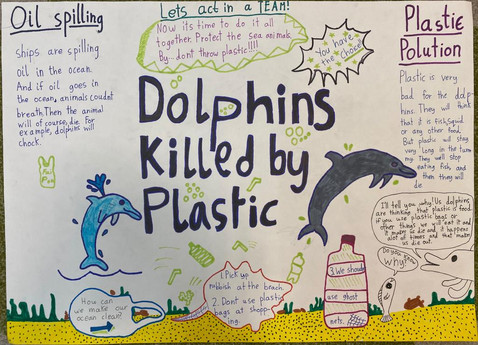Sharing The Planet - Oceans
- Shameer Bismilla

- Dec 14, 2020
- 3 min read
I can't believe that the term is over... I was thrilled to see the children digging deeper, practicing their research skills. Being a follower of Anne Goudvis, Stephanie Harvey and Brad Buhrow and their inquiry approach, I've merged the inquiry learning process with the reader's and writer's workshop approach. There was wonder in my students' faces. It was impossible to resist probing into their curious minds. They were so ready to share their background knowledge about oceans.
Curiosity in action
We started the term with children bringing photographs of their beach holidays. This led to animated discussion on how we use oceans, followed by children expressing themselves through their drawings and writing.
"This is how I use the ocean":
I went deeper by reading an anonymous provocation poem "If all the world were paper..."
Reflecting on the provocation poem:
My favourite mantra from my literacy gurus Donald Greaves, Stephanie Harvey, Ann Goudvis, Brad Buhrow and Lucy Calkins is "Teach the reader, not the reading; teach the writer, not the writing". I have practiced this in all my lessons especially in my researcher's workshop.
In a reader's and writer's workshop, it is important to give children choice, access and volume. To promote curiosity, comprehension, critical thinking and collaboration, the classroom was overflown with a variety of non-fiction texts. These gave them opportunities to respond, encouraged them to read, write and talk about the information they had gathered. In essence, the reader's and writer's workshop, as well as the unit of inquiry were converted into researcher's workshop.
During the researcher's workshop, instructions were explicitly provided through various mini lessons. Children were thinking aloud by recording ideas and connections while reading. They were also highlighting information, jotting notes on Post-its and sharing their thinking with their peers.
Teaching questioning strategy
To cultivate curiosity, questioning strategy is one way to engage and spur wonders. Choosing appropriate text helps children to study text features in detail. This will lead them to ask many questions, which is a starting point for the investigation process to take place.
We read "Recess At 20 Below", an engaging narrative text written by Cindy Lou Aillaud. My students were fascinated by the world map and studied the elements of hemispheres of earth. They were intrigued by the story that focusses on how cold it can get and how kids cope under such temperature. They were mesmerised by the wide array of photographs and interesting content that spun off curiosity and questions. During the read-aloud session, children jotted down and drew questions about the text. They had a chance to review their questions by researching further using the internet.

We used this chart taken from "Inquiry Illuminated" to record the voice in our head. The children used the strategy of 'stop, think and react' as they read the books.
They used thinking stems such as "This makes me think about..."; "I wonder why..."; "This reminds me of..."
Investigation
Content in action:
The Grade 2s were ready to embark on their research project. Our central idea for this unit was "Living things depend on humans sustainably managing ocean resources". They were keen to be oceanographers as they discovered new information about ocean creatures and how we are the predominant factor behind many challenges that these creatures face.
Students had some essential questions such as:
- what are humans doing that harms the ocean;
- what are humans doing to prevent the destruction of ocean environment;
- how are ocean animals, plants and humans connected; and
- how can humans sustain the ocean environment.
After reading, talking, drawing and writing, students identified their favourite ocean creature. They used their background knowledge to plan their research by using the organiser below to create their posters and ready to move to the next stage, which is presenting to their peers and families.
Students take note and annotate resources:
Students express opinions and responses using the graphic organiser below:
Some lingering questions were noted down and students were able to get answers via peer discussions and/or researching on the internet (you can download the organiser here).
Planning of poster:
Children collected their new learning by drawing and writing new facts. They also chose to organise their information in a systematic way by using the planning template (available for download here). They used the essential questions as a guide to create their posters.
Presentation:
Children presented the information by creating a large poster displaying their learning. Their posters are colourful and fun to read. Anyone who reads this could see how they have merged their new learning with their background knowledge.

It has been a fulfilling research journey! In addition to what you can see here, I have used many other resources from 'Teachers Pay Teachers' and a plethora of non-fiction magazines, anchor charts, videos. Leave a comment on this post if you would like me to share more on these resources.


























































































































Comments